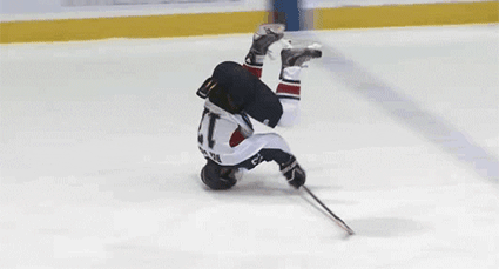

LFO-Bracket (LFO to LBI): Tessa Virtue and Scott Moir enter on left forward outside edges and exit on left back inside edges. The skater changes both direction (front to back or back to front) and edge (inside to outside or outside to inside) and the blade turns in the opposite direction of the overall turn. RBI-Counter (RBI to RFI): Tessa Virtue enters on a right back inside edge and exits on a right forward inside edge. This is also his entry to his triple axel and the “back counter” entry to make the axel look as if it “came out of nowhere” that skaters do, since counter-clockwise jumpers take off for the axel from a left forward outside edge. LBO-Counter (LBO to LFO): Yuzuru Hanyu enters on a left back outside edge and exits on a left forward outside edge. RFO-Counter (RFO to RBO): Scott Moir enters on a right forward outside edge and exits on a right back outside edge. LFI-Counter (LFI to LBI): Tessa Virtue enters on a left forward inside edge and exits on a left back inside edge. RBO-Counter (RBO to RFO): Scott Moir enters on a right back outside edge and exits on a right forward outside edge. LBI-Counter: Tessa Virtue and Scott Moir enter on left back inside edges and exit on left forward inside edges. RFI-Counter (RFI to RBI): Tessa Virtue and Scott Moir enter on right forward inside edges and exit on right back inside edges. LFO-Counter (LFO to LBO): Mikhail Kolyada enters on a left forward outside edge and exits on a left back outside edge. The blade turns in the direction of the exit curve. The skater changes from back to front or front to back, maintaining the same edge (outside to outside or inside to inside). You can also see the ice mark of a rocker in this gif. RBO-Rocker (RBO to RFO): Yuzuru Hanyu enters on a right back outside edge and exits on a right forward outside edge. LBI-Rocker (LBI to LFI): Yuzuru Hanyu enters on a left back inside edge and exits on a left forward inside edge.

RFI-Rocker (RFI to RBI): Scott Moir enters on a right forward inside edge and exits on a right back inside edge. LFO-Rocker (LFO to LBO): Tessa Virtue and Scott Moir enter on left forward outside edges and exit on left back outside edges. LBO-Rocker (LBO to LFO): Lorraine McNamara and Quinn Carpenter enter on left back outside edges and exit on left forward outside edges. RBI-Rocker (RBI to RFI): Scott Moir enters on a right back inside edge and exits on a right forward inside edge.


LFI-Rocker (LFI to LBI): Tessa Virtue and Scott Moir enter on left forward inside edges and exit on left back inside edges. You can also see the ice marks of a rocker in this gif. RFO-Rocker (RFO to RBO): Elena Ilinykh and Nikita Katsalapov enter on right forward outside edges and exit on right back outside edges. The blade turns in the direction of the entry curve. In singles skating, the direction of the step/turn (clockwise or counter-clockwise) is important because a skater must have 5 types of difficult steps/turns in both directions to achieve level 4 on their step sequence, so I will also separate them by their direction. This is especially true for rockers and counters since skaters maintain the same entry and exit edge (inside to inside or outside to outside) in both. For 3 of the difficult one foot turns (rocker, counter, bracket), I’ve also included examples from each of the 8 entry edges because in my opinion, they are the hardest to tell apart of the steps/turns. For singles/pairs, the 6 difficult steps/turns are rocker, counter, bracket, choctaw, twizzle, and loop. For ice dance, the 6 difficult steps/turns are rocker, counter, bracket, choctaw, outside mohawk, and twizzle. I’ve made a guide to the ISU classified difficult steps/turns.


 0 kommentar(er)
0 kommentar(er)
